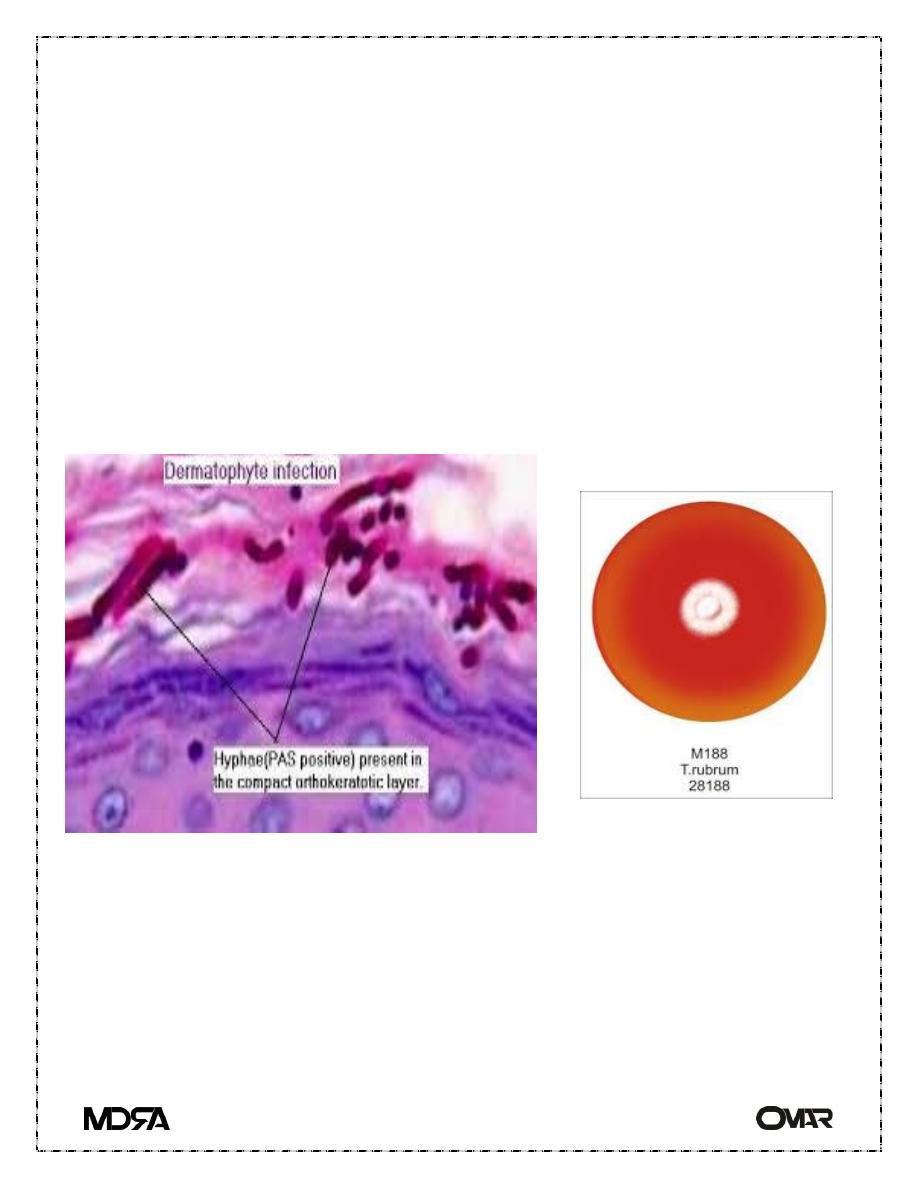
1
Dermatophyte
• Dermatophytes means "skin" and -"phyte
Dermatophytes
cause infections of the skin, hair and nails, obtaining nutrients
from keratinized material. The organisms colonize the keratin
tissues causing inflammation as the host responds to metabolic
by-products. Some of these skin infections are known as
ringworm or tinea. Dermatophytes usually do not invade living
tissues, but colonize the outer layer of the skin. Occasionally the
organisms do invade subcutaneous tissues, resulting in kerion
development.
Types of dermatophyte infections
1-Tinea pedis or athlete's foot
2 -Tinea cruris or jock itch
3- Tinea corpora or ringworm of the body
4- Tinea faciei or facial ringworm
5- Tinea capitis or blackdot ringworm
6 -Tinea capitis or scalp ringworm
7- Tinea manuum or ringworm of the hands
8- Onychomycosis, tines unguium, or ringworm of the nail.
Diagnosis
• Rapid testing can be done with scraping of the nail, skin, or scalp.
• Fungal culture medium is used for positive identification of the
species. Usually fungal growth is noted in 5 to 14 days. Culture
characteristics such as surface texture, topography and

2
pigmentation are variable so they are the least reliable criteria for
identification. Clinical information such as the appearance of the
lesion, site, geographic location, travel history, animal contacts
and race is also important. A special agar called Dermatophyte
Test Medium (DTM) has been formulated to grow and identify
dermatophytes It is incubated at room temperature for 10 to 14
days. If the fungus is a dermatophyte, the medium will turn bright
color test. The red. If the fungus is not a dermatophyte, no color
change will be noted. If kept beyond 14 days, false positive can
result even with non-dermatophytes.
Transmission
• Dermatophytes are transmitted by direct contact with infected
host (human or animal) or by direct or indirect contact with
infected exfoliated skin or hair in clothing, combs, hair brushes,
theatre seats, caps,, bed linens, shoes, socks, towels, hotel rugs,
sauna, bathhouse, and locker room floors. Depending on the
species the organism may be viable in the environment for up
to 15 months. There is an increased susceptibility to infection
when there is a preexisting injury to the skin such as scars,
burns, excessive temperature and humidity
Classification
• Dermatophytes are classified as anthropophilic (humans),
zoophilic (animals) or geophilic (soil) according to their normal
habitat.

3
• Anthropophilic dermatophytes are restricted to human hosts
and produce a mild, chronic inflammation.
• Zoophilic organisms are found primarily in animals and cause
marked inflammatory reactions in humans who have contact
with infected cats, dogs, cattle, horses, birds, or other animals.
This is followed by a rapid termination of the infection.
Geophilic species are usually recovered from the soil but
occasionally infect humans and animals. They cause a marked
inflammatory reaction, which limits the spread of the infection and
may lead to a spontaneous cure but may also leave scars
Treatment
• Tinea corpora (body), tinea manus (hands), tinea cruris (groin),
tinea pedis (foot) and tinea facie (face) can be treated topically.
• Tinea unguum (nails) usually will require oral treatment with
terbinafine, itraconizole, or griseofulvin. Griseofulvin is usually
not as effective as terbinafine or itraconizole. A lacquer (Penlac)
can be used daily, but is ineffective unless combined with
aggressive debridement of the affected nail.
• Tinea capitis (scalp) must be treated orally, as the medication
must be present deep in the hair follicles to eradicate the
fungus. Usually griseofulvin is given orally for 2 to 3 months.

4
Clinically dosage up to twice the recommended dose might be
used due to relative resistance of some strains of
dermatophytes.
Tinea pedis is usually treated with topical medicines, like
ketoconazole or terbinafine, and pills, or with medicines that
contains miconazole, clotrimazole, or tolnaftate. Antibiotics may be
necessary to treat secondary bacterial infections that occur in
addition to the fungus (for example, from.
